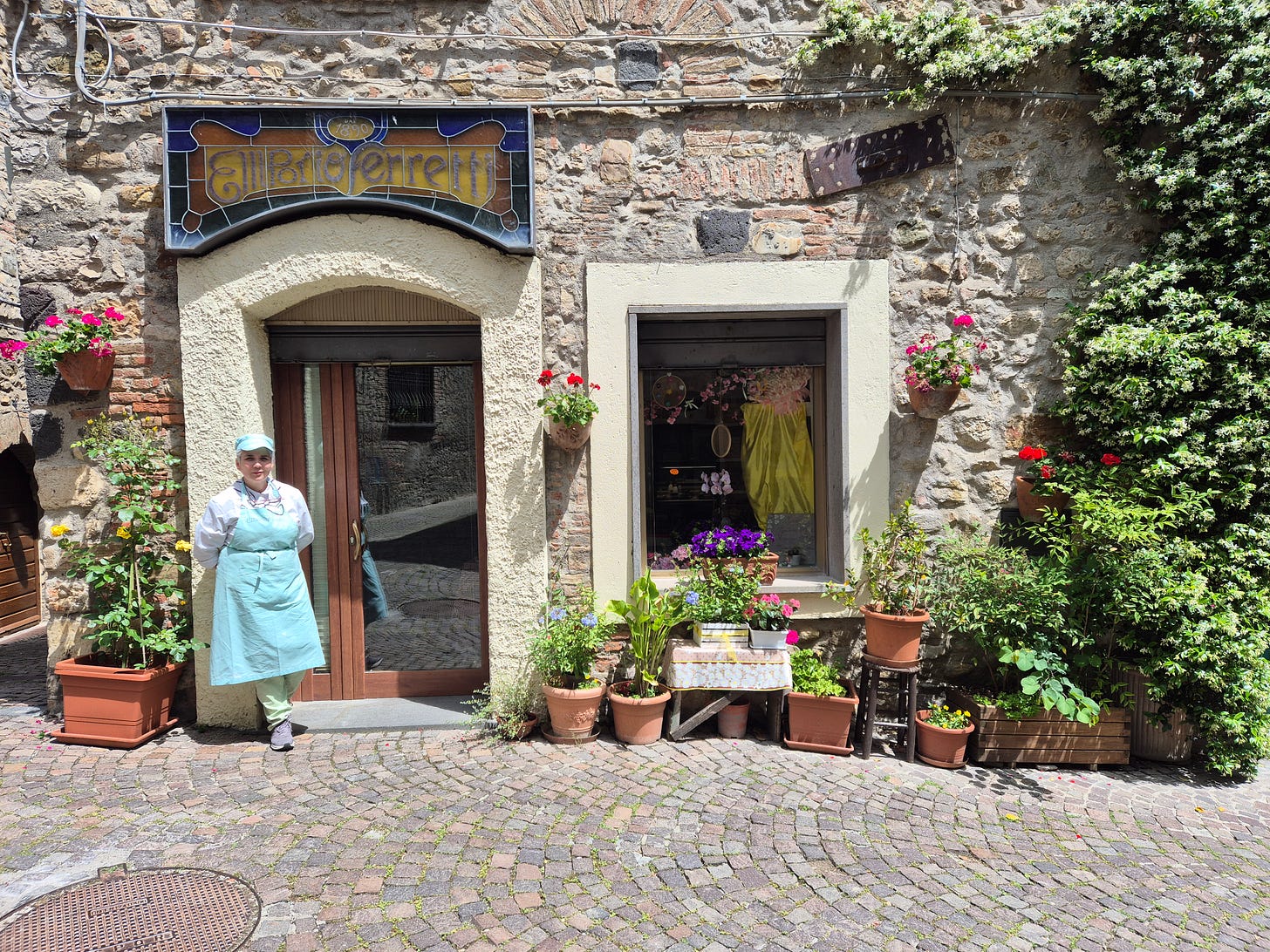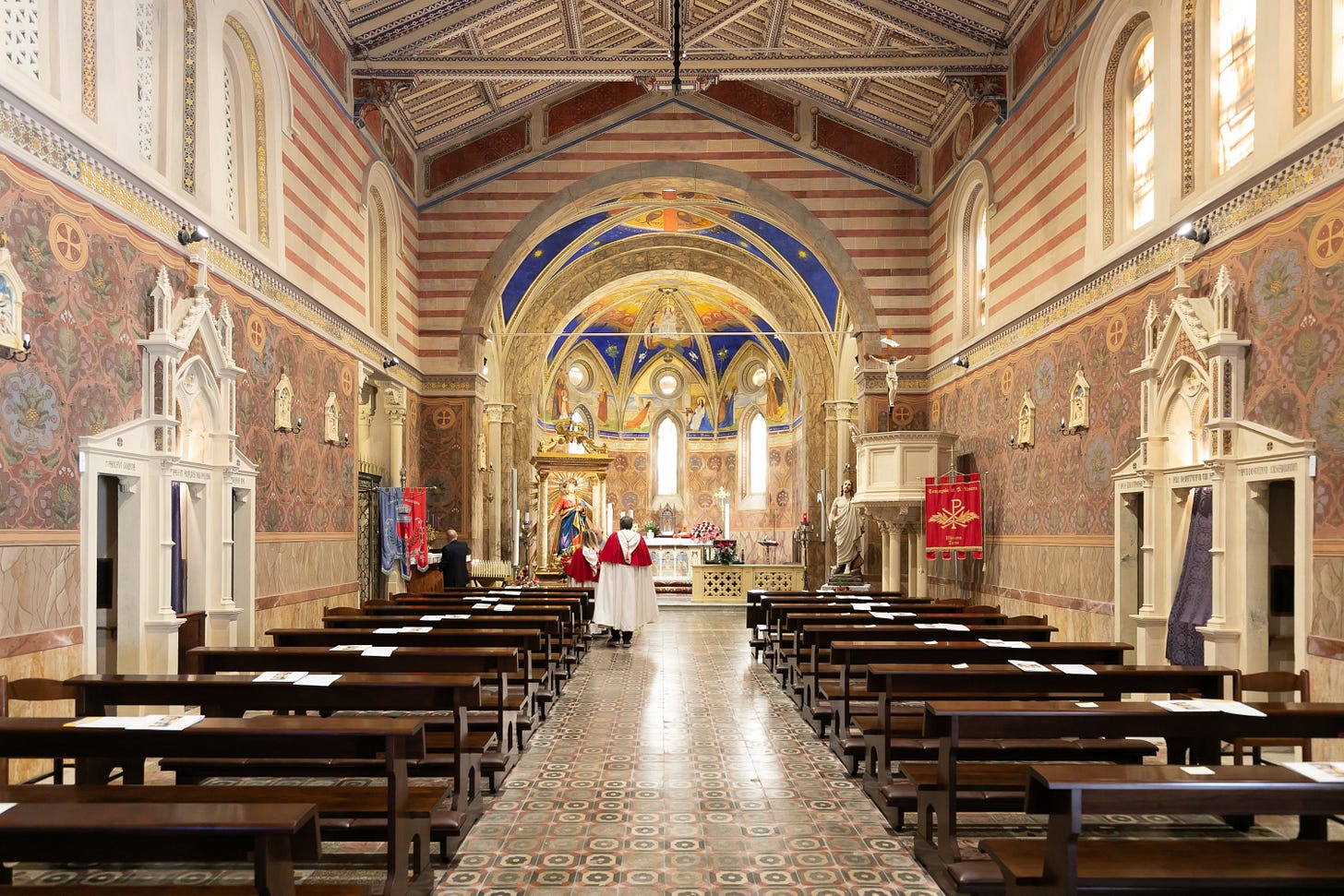This week’s issue is a guest post written by Elizabeth Heath, one of the top American journalists based in Italy and founder of Villaggio Tours. Liz moved to Allerona, one of the Borghi più belli d’Italia (most beautiful villages in Italy) in 2009, when she married Paolo Marchetti, who was born and raised there. She’s giving us a peek at Allerona, plus an exclusive discount code for readers who want to join her on one of the small group tours she organizes there.
If you’ve never heard of Allerona, it’s hardly your fault. It’s not on any international tourism radar screens and it has no major attractions to draw visitors. For people who do pass through, they may remember it as just another pretty little Italian hill town. But Allerona is my hill town, so I’m happy the New Roman Times is giving me the chance to tell you about it.
Allerona is located in the province of Terni in southwest Umbria, and sits right near the borders, or confini, of Lazio, the region of Rome, and Tuscany, which needs no introduction. It was founded, officially at least, in the 1100s, when similar walled hill towns sprang up all over the central Italian peninsula. (To condense several hundred years of history, the reason for all those hill towns developing is that with the definitive fall of the Roman Empire, low-lying settlements became vulnerable to waves of violent invasions. Fortified hill towns, while not impenetrable, were certainly more secure.
Charles VIII, King of France and the Holy Roman Empire, razed Allerona’s town walls in the late 1400s. Remains of the old walls still encircle parts of Allerona, and the borgo, or historic center, still follows the footprint of the original walls. For centuries part of the Papal States, Umbria, along with the rest of the peninsula, became part of the Kingdom of Italy in 1861. In the waning days of WWII, German and Allied troops passed right through Allerona, the latter chasing the former towards the Gothic Line and ultimately, to defeat. After the war, Umbria and with it Allerona, became part of the Republic of Italy.
For a little town that’s seen so much action over the centuries, things are pretty quiet here now. Like thousands of other villages across Italy, Allerona is a “dying town.” Its population has been in steady decline for several decades, mostly due to lack of both opportunity and convenience, and to Italy’s shift away from small-scale farming. There’s more commercial activity in Allerona Scalo, the lower town that sprang up when the railroad was built, and Scalo is closer to jobs in Orvieto and for commuters to Rome.
Instead, up in Allerona Paese, the narrow cobblestone streets are pedestrian-only—most aren’t even wide enough for a car to pass—and our remaining businesses are a bar, a pharmacy, a post office, a small grocery store and a fine dining restaurant, La Panatella. For young people who leave and go to university, there’s little other than nostalgia to draw them back to Allerona. About 200 people live in the upper town now, including in farmhouses in the countryside.
So, why should people include Allerona in their tour of Umbria?
There’s something here that really touches visitors—maybe it’s the feeling of wandering through a medieval film set (except that it’s real), of walking through a gate that’s stood since the 1100s, and up and down the crooked alleys that would still be recognizable were a resident from the 1400s to visit today. There’s the sweet little “poor Baroque” style church where my husband and I were married, a public laundry where the stone basins are rubbed smooth from centuries of use, and soaring views of the countryside from the piazza just outside the walls.
On a pleasant day, there may be a handful of people sitting outside at our town bar, and if you look friendly enough, one of them may buy you an espresso or a glass of wine. If you spend a night or two (we’re renovating our own guesthouse but in the meantime, there’s a nice guesthouse, Bed & Basta, and several rental apartments in town), by the time you leave, you’ll be welcomed at the bar like an old friend.
Allerona is also its people. Those of us who choose to make our homes here value the dimensions of our tiny village, even if we all wish our population could reverse its downward trend. Like the people who’ve been here all their lives do, I’ve grown to love the familiarity of such a small place. People who visit us for the first time are always surprised that we know everyone in town, and will usually exchange a few friendly words when we see a neighbor—and we’re all neighbors.
With our new tour company, Villaggio Tours, we have two missions, or rather, a combined one: to give guests an authentic taste of Italian village life and breathe new life into our small town. Our small-group tours allow guests to sleep in restored guesthouses inside the village walls, enjoy private, homemade dinners and plenty of great local wine, and take day trips to local points of interest, including Orvieto. We go on nature hikes, take lessons in artisanal craft-making, visit winemakers and olive oil mills, and eat at our favorite restaurants. Every evening, guests return “home” to Allerona, and to the warm embrace of the village.
We work with local businesses, accommodations, purveyors and tour providers to ensure that our offerings are truly grounded in our village and the surrounding borderlands. For me, personally, it’s a small-scale effort to give back to the place that has given me so much—a family, a home, and a career doing something I love. Broadly, we hope to help cultivate a greater appreciation and interest in visiting, not just for Allerona, but for other towns like it. “Hidden gems” may be an overused term in travel lingo, but we really do have one in our pocket here.
If you’d like to see for yourself, please come join us on a tour! Readers of the New Roman Times are eligible for a $250 discount off any 7- or 10-night tour. Just apply the promo code NEWROMANTIMES when booking. And if you have questions about any of our tours or whether Villaggio Tours is right for you, hit me up at liz@villaggiotours.com.
Ci vediamo presto!
Further Reading
To learn more about Liz and Villaggio Tours, check out my interview with her here.
Liz shared her insights about why visiting little villages is a good way to get off the tourist trail and experience an authentic side of Italy in my recent article for AFAR.
Curious about why Umbria has so many hill towns? Check out Liz’s blog post on the topic.
If you want to learn about another “Dying Town,” (one where Liz brings travelers with Villaggio Tours), check out my postcard from Civita di Bagnoregio, which includes some of her tips.
You can see all of the New Roman Times’ issues about under-the-radar destinations here.











